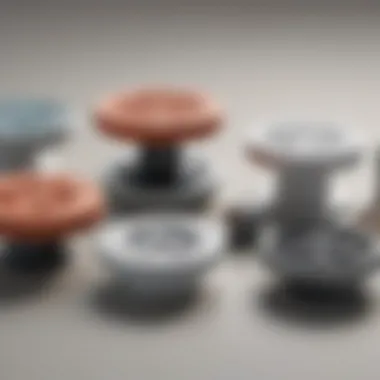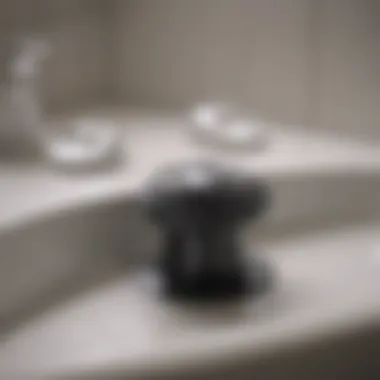Understanding Toilet Drain Caps: Importance and Maintenance


Intro
Toilet drain caps are a critical yet frequently neglected aspect of bathroom plumbing. Many homeowners may not recognize their importance and may not consider regular maintenance of these components. However, understanding toilet drain caps can help prevent drainage issues, extend the lifespan of plumbing systems, and avoid costly repairs later on.
These caps serve several crucial purposes, including preventing debris from entering the waste pipe, housing a variety of drainage systems, and facilitating easier maintenance. This article provides an in-depth analysis of toilet drain caps by exploring their importance, various types, and maintenance practices.
By cultivating this knowledge, homeowners and enthusiasts can ensure optimal performance in their plumbing designs.
Prelims to Toilet Drain Caps
Understanding toilet drain caps is fundamental to maintaining the functioning of bathroom plumbing. These components, while often overlooked, play a crucial role in ensuring efficient waste removal. Their effectiveness directly correlates to overall plumbing performance and homeowners’ peace of mind regarding hygiene and odor control.
Toilet drain caps serve as barriers that prevent sewer gases from entering a bathroom, while also protecting the plumbing system from foreign objects. Failing to appreciate their importance can lead to various plumbing issues, including bad odors and costly repairs. By grasping the purpose and value of these components, one can make informed decisions on maintenance and replacements when necessary.
Definition and Purpose
A toilet drain cap is a cover that fits over the drain opening of a toilet. Its primary purpose is to prevent debris and foreign materials from entering the drain and disrupting the plumbing system. This small yet significant part ensures that waste is effectively channeled away without obstruction.
Additionally, toilet drain caps help in blocking the escape of sewage odors from the plumbing system. They may also aid in facilitating easier access for plumbing maintenance. In this sense, their role extends beyond merely covering the drain; they are integral to maintaining a proper sanitation environment within the bathroom.
Historical Context
The use of toilet drain caps has evolved over the years alongside advancements in plumbing technology. Early sanitation systems lacked effective means to control smells and block unauthorized access to sewer lines. With the growing understanding of hygiene in the 19th century, various inventions were developed to improve waste management.
Modern toilet drain caps are designed based on decades of knowledge about plumbing efficiency and health safety. Today, there are diverse types tailored to meet different needs and preferences. Recognizing this historical context gives valuable insight into why these components are essential in contemporary plumbing systems.
Types of Toilet Drain Caps
Understanding the types of toilet drain caps is crucial for homeowners and enthusiasts alike. Each type serves a specific function and provides distinct benefits regarding installation, maintenance, and functionality. Selecting the appropriate cap can enhance the overall efficiency of the plumbing system and prevent costly repairs in the long run. Below are the primary types of toilet drain caps, which ensure effective sealing and optimal drainage performance.
Standard Caps
Standard caps are the most common types used in residential plumbing. Primarily made from durable plastic, these caps offer a straightforward approach to sealing the toilet drain. The key advantage is their affordability and ease of installation. They fit tightly on the drain, preventing unwanted odors and wastewater from escaping into the bathroom. However, they may not be suited for high-traffic or high-capacity toilets. Frequent usage can lead to wear and tear, requiring timely replacement. Regular checks can help ensure they remain effective.
Snap-in Caps
Snap-in caps provide a secure and hassle-free option for sealing toilet drains. They are designed to easily click into place, making installation and removal simple. This design feature is particularly beneficial during maintenance or cleaning tasks. These caps are typically made of resilient plastic or rubber materials, which allow for flexibility and prevent leaks. Additionally, the snap-in mechanism ensures a snug fit that minimizes the risk of accidental dislodgement. However, it is essential to ensure they are properly seated to avoid any issues.
Screwed Caps
Screwed caps feature a threaded design that secures them firmly onto the toilet drain. This build is advantageous for areas prone to movement or pressure fluctuations, as they can withstand greater force without loosening. Screwed caps are often manufactured from metals or robust synthetic materials, ensuring long-lasting use. Regular maintenance checks should be performed to ensure the threads remain clean and free from debris, which can compromise their effectiveness. Although they require more effort to install, their reliability in high-stress situations makes them a worthy choice.
Adjustable Caps
Adjustable caps are versatile solutions that can be customized to fit various drain sizes. This feature is particularly useful in older homes where standard sizes may not apply. Made from strong materials, adjustable caps can withstand intense stress and provide a secure seal. Some models even come with seals to further improve their effectiveness. Given their adaptable nature, they might require a bit more attention during the installation process. Ensuring the correct fit will enhance their functionality and prevent future issues. Regular monitoring will minimize potential risks associated with improper sealing.
"Understanding and selecting the right type of toilet drain cap can significantly impact the plumbing system's efficiency and longevity.”
Materials Used in Toilet Drain Caps
In the realm of toilet drain caps, the materials utilized play a pivotal role in their effectiveness and durability. Understanding the various materials is essential not only for selecting the right cap but also for maintaining proper plumbing function. Each material brings its own set of advantages and considerations. The selection will impact aspects of cost, longevity, and even maintenance requirements. Therefore, a careful assessment of the materials contributes significantly to optimal toilet drainage performance.


Plastic Caps
Plastic caps are a prevalent choice in many households due to their lightweight nature and cost-effectiveness. These caps typically are made from materials like PVC or ABS. A primary benefit of plastic caps is their resistance to rust and corrosion, which makes them ideal for environments with moisture and potential water exposure. They are also easy to install and often come in various colors to match the decor of a bathroom.
However, plastic caps can be susceptible to brittle failure under extreme temperatures or heavy pressure. Over time, exposure to sunlight can also degrade certain plastics. This necessitates regular inspections and potential replacements, especially in environments where cap durability may be compromised.
Metal Caps
Metal caps, such as those made from stainless steel or brass, are recognized for their durability and strength. They provide a robust solution for drain protection, often willing to withstand high-pressure scenarios. Metal caps are not only functional but also add an aesthetic appeal to the bathroom fixtures due to their sleek finish.
The downside, however, is the potential for corrosion over time, even with metals that are considered rust-resistant. Maintenance requirements are higher as these caps will need regular inspections for any signs of wear. Moreover, metal caps often come at a higher price point, which can be a consideration for homeowners focusing on budget.
Composite Materials
Composite materials, blending plastic and metal, offer a unique alternative that balances the advantages of both. These caps are designed to resist corrosion like metals while offering the lightweight nature of plastics. Made from components such as fiberglass or reinforced plastic, they can handle environmental stress better than traditional plastic caps alone.
One significant advantage of composite materials is their ability to withstand harsh chemicals and temperature extremes, making them suitable for various plumbing applications. However, the challenge remains in their availability and potentially higher cost compared to standard plastic options. As with other materials, it’s essential to monitor for any signs of degradation over time.
In summary, choosing the right material for toilet drain caps is crucial for long-term plumbing health and maintenance affordability. Each material has its pros and cons, affecting durability and overall function in distinct ways. Regular evaluations based on the selected material can help ensure optimal operation and system longevity.
Installing Toilet Drain Caps
Toilet drain caps play a vital role in plumbing systems. Proper installation ensures that the drainage operates smoothly, preventing leaks and blockages. When installing toilet drain caps, it is essential to consider several factors. Doing it correctly can save money and time on repairs in the long run. The importance of this topic cannot be understated as it affects overall functionality.
Tools Required
Before beginning the installation process, gather all necessary tools. This will streamline the task and help avoid interruptions. Here is a list of what you typically need:
- Adjustable Wrench: Useful for securely tightening caps.
- Screwdriver: Depending on the type of cap, you may need a flathead or Phillips screwdriver.
- Plumber's Tape: Helps create a watertight seal.
- Bucket: To catch any excess water during installation.
- Gloves: Keep your hands safe and clean.
Step-by-Step Installation Guide
Installing toilet drain caps involves clear steps. Follow this simple guide:
- Turn Off Water Supply: Locate and turn off the water supply to prevent any flooding.
- Clear the Area: Remove any obstructions around the toilet. This ensures easy access.
- Inspect the Drain: Check for debris or damage in the drain. Cleaning it helps ensure a smooth installation.
- Apply Plumber's Tape: Wrap plumber’s tape around the threads of the drain if needed. This enhances sealing.
- Position the Cap: Place the cap over the drain, ensuring it aligns correctly.
- Secure the Cap: Use your hand to tighten it initially. Then, use an adjustable wrench to tighten further, if necessary. Make sure not to over-tighten and damage the cap.
- Check for Leaks: Once everything is in place, turn on the water supply and check for leaks. If water seeps through, readjust the cap or reapply the tape.
Common Mistakes to Avoid
It’s easy to make errors during installation. Being aware of these can help you avoid significant issues:
- Skipping the Inspection: Neglecting to check the drain can lead to future blockages.
- Overtightening the Cap: This can crack the cap and cause leaks.
- Ignoring Plumber's Tape: Not using tape can compromise the seal and lead to leaks.
- Failing to Check Alignment: Misalignment can cause further drainage issues.
Proper installation of toilet drain caps ensures smooth plumbing operation. Regular inspections and preventive measures help maintain their effectiveness.
Maintenance of Toilet Drain Caps
Toilet drain caps are crucial for the effective functioning of plumbing systems in our homes. Maintenance of these caps is often overlooked, but it directly influences drainage efficiency, longevity of the plumbing system, and hygienic bathroom conditions. Regular upkeep not only prevents minor issues from escalating but also enhances the overall performance of the toilet. Maintaining drain caps ensures that they remain intact and function as intended, preventing leaks and blockages.
Regular Inspection Practices
Regular inspections of toilet drain caps are an essential practice for any homeowner. It is advised to check the caps periodically for signs of wear and tear. Inspections should include:
- Visual Examination: Look for cracks, discoloration, or loose fittings on the caps. Any visible damage can indicate potential leaks.
- Checking for Odors: Unpleasant smells may signal that the cap is not sealing properly or that there are blockages leading to backflow issues.
- Listen for Strange Noises: If you hear unusual sounds when the toilet is flushed, it may imply that the drain cap is not functioning correctly.


An inspection every couple of months is a practical guideline to follow, ensuring your drain caps are always in optimal condition.
Cleaning Techniques
Keeping toilet drain caps clean is vital for their performance. Dirt and grime can accumulate and affect how well the cap seals. Effective cleaning techniques include:
- Use Mild Detergents: Combine warm water with a mild detergent and scrub the cap with a non-abrasive cloth or sponge. This method is gentle enough to avoid damage but effective for removing buildup.
- Rinse Thoroughly: Always rinse the cap with clean water to ensure all detergent is removed, preventing any residue that may attract more dirt in future.
- Vinegar or Baking Soda: For stubborn stains, a mixture of vinegar and baking soda can help. Apply it, let it sit for a few minutes, and scrub gently.
Excess buildup can lead to blockage and improper sealing, impeding drainage efficiency.
Signs of Damage
Recognizing signs of damage is crucial for effective maintenance. Here are some common indicators:
- Visible Cracks or Breaks: Any physical damage to the cap should be addressed immediately.
- Water Leaks: Puddles around the base of the toilet may indicate that the cap is compromised.
- Decreased Flush Performance: If the toilet is flushing slowly or ineffectively, it could be a sign of a damaged drain cap.
Monitoring these signs will allow homeowners to take proactive steps in maintaining their plumbing systems.
Common Problems with Toilet Drain Caps
Toilet drain caps are a vital part of plumbing systems in any home. However, like any component, they can encounter issues over time. Understanding these problems is essential for maintaining the efficiency and health of your toilet system. An issue with the drain cap can lead to bigger concerns such as water damage, unsanitary conditions, and costly repairs. Therefore, recognizing the common problems associated with toilet drain caps can help homeowners take preventive measures and mitigate any potential issues.
Leaking and Its Causes
Leakage is one of the most prevalent problems associated with toilet drain caps. A leak can occur due to several factors. Wear and tear is often the primary cause, especially in older caps. Over time, seals can degrade, materials may crack, and joints can become loose, resulting in leaks.
Another common cause of leaks is improper installation. If a cap is not secured correctly, water can escape through gaps, leading to leakage. Additionally, using incompatible materials can also cause leaks. For example, a plastic cap placed on a metal drain might not create a proper seal, leading to leakage.
Signs of a leak appear as water pooling around the base of the toilet or damp spots on the floor. Homeowners should address leaks quickly, as they can lead to mold growth and structural damage if not fixed.
Blockages and Backflow Issues
Blockages are another significant problem that can arise with toilet drain caps. Over time, debris, hair, and other foreign materials can accumulate in the drain, hindering water flow. When water cannot pass through efficiently, backflow issues can occur.
Backflow is not only undesirable but can also lead to unsanitary conditions. Wastewater can back up into the toilet or other areas of the plumbing system. This problem can stem from a clogged drain, the installation of incorrect caps, or blockages in the main sewage line.
To prevent these issues, regular cleaning and inspection of the toilet drain cap can help. Homes may consider installing drain strainers to catch debris before it enters the drain line, thus reducing the chance of blockages.
Corrosion and Deterioration
Corrosion is a long-term problem for toilet drain caps, particularly those made from metal materials. Over time, exposure to moisture and harsh chemicals can erode the cap's surface. Deterioration can affect the integrity of the cap, leading to leaks and ineffective seals.
Some indicators of corrosion include rust spots and flaking material on the cap. If not addressed, corrosion may compromise the entire plumbing system, necessitating expensive repairs or replacements.
To mitigate corrosion, using caps made from corrosion-resistant materials is advisable. Regular maintenance and inspection will also allow homeowners to catch these issues early, prolonging the life of their plumbing system.
Regular attention to toilet drain caps can save homeowners from severe plumbing issues down the line. Problems that seem small can quickly escalate into more significant concerns, making preventive measures crucial.
Preventive Measures for Toilet Drain Caps
Toilet drain caps may appear to be small components in the grand scheme of plumbing systems, yet they serve significant roles in maintaining the efficiency and hygiene of bathroom facilities. Preventive measures concerning toilet drain caps not only enhance their longevity but also prevent costly repairs in the future. Understanding and implementing these measures is essential for any homeowner who values the health of their plumbing system.
Choosing Quality Materials


The foundation of a good preventive strategy begins with the selection of high-quality materials for toilet drain caps. Investing in caps made from durable materials ensures resistance against wear and tear. For instance, metal caps, particularly those made from stainless steel, often provide greater longevity compared to plastic alternatives. However, plastic caps can also be effective if they are of high-quality and resistant to degradation.
When selecting materials, consider factors like
- Corrosion resistance: Metal caps should have protective coatings to resist rust.
- Temperature tolerance: Caps need to withstand temperature changes without warping.
- Compatibility: Ensure the material is compatible with other plumbing components to avoid reactions.
The durability of the material directly contributes to the overall efficiency of the drainage system and reduces the likelihood of malfunctions.
Regular Maintenance Schedule
Establishing a regular maintenance schedule is another vital preventive measure. Periodic checks can catch small issues before they escalate. Recommended practices include:
- Monthly Inspections: Look for visible cracks, warping, or signs of wear. Tighten any loose screws if applicable.
- Cleaning: Regularly remove any debris that might accumulate around the cap to prevent blockages.
- Testing for Leaks: Observe for any signs of leaking after heavy use, especially after a cleaning has been performed.
By staying proactive in maintenance, homeowners can enjoy uninterrupted plumbing service and prolong the lifespan of their toilet drain caps.
Professional Consultations
While DIY maintenance is reasonable for many tasks, there are instances when consulting professionals is prudent. They bring expertise that can greatly benefit the evaluation and repair of your plumbing system. For toilet drain caps, professional services can offer:
- Inspections: Comprehensive evaluations of the entire plumbing system, identifying potential problem areas that may not be visible to the owner.
- Installation: Proper fitting and installation of drain caps that ensure compatibility with existing plumbing systems.
- Repairs: Timely and efficient remedies for existing issues, such as leaks or cracks, preventing more extensive damage.
Incorporating professional perspectives ensures that a plumbing system functions optimally, reducing the likelihood of issues arising from inadequate installations or materials.
Proper care of toilet drain caps is crucial. Preventive measures help maintain system efficiency, reduce repairs, and protect the integrity of your plumbing.
By adopting these preventive measures, homeowners can safeguard their toilets against many common issues. Quality materials, regular maintenance, and professional insights form a solid trio of strategies to maximize the reliability and functionality of toilet drain caps.
Impact of Toilet Drain Caps on Plumbing Systems
Toilet drain caps serve an essential role in the plumbing systems of homes and buildings. Understanding their impact on plumbing systems is crucial for homeowners and professionals alike. These seemingly minor components significantly influence both functionality and efficiency.
Overall Drainage Efficiency
Efficient drainage relies heavily on the integrity of toilet drain caps. When these caps function correctly, they support seamless water flow through the plumbing system. Any obstruction caused by damaged or missing caps can lead to blockages, resulting in slow drainage or backups. This situation often escalates to more serious plumbing issues, leading to costly repairs.
Properly sealed toilet drain caps prevent the escape of odors and gases while maintaining optimal drainage. A well-installed cap ensures the system operates effectively, reducing the likelihood of clogs. It is essential to regularly check the caps for wear or degradation, especially in older plumbing systems. This simple action helps sustain a high level of drainage efficiency, protecting the entire plumbing network from potential issues.
System Health and Longevity
The health of a plumbing system is not only about the visible aspects but also involves unseen components like toilet drain caps. The longevity of pipes and connected fixtures can be enhanced by maintaining these caps. They act as a barrier, preventing debris and foreign materials from entering the drainage system.
When the integrity of a toilet drain cap is compromised, it can allow harmful substances to clog pipes, leading to corrosion or even more severe damage over time. This can significantly reduce the lifespan of plumbing components. Regular inspections are necessary to ensure that the caps remain in good condition and function as intended.
> Maintaining toilet drain caps is a proactive measure. This can prevent costly plumbing repairs and extend the life of your system.
Ending
In summary, the importance of toilet drain caps cannot be overstated. These components play a key role in maintaining the functionality of plumbing systems in homes. The effectiveness of drain caps directly influences overall drainage efficiency. Understanding the various types of caps available can aid homeowners in making informed decisions regarding their plumbing needs. Additionally, engaging in proper maintenance practices can prolong the lifespan of these caps and minimize potential issues like leaks and blockages.
Regular inspections and cleaning help mitigate any risk of damage from corrosion or other elements. It is essential to choose quality materials and create a maintenance schedule to keep plumbing systems in optimal working order. Ultimately, ensuring that toilet drain caps are in good condition results in better drainage performance and less frequent costly repairs, which benefits homeowners in the long run.
Summary of Key Points
- Toilet drain caps are essential for plumbing efficiency.
- Various types include standard, snap-in, screwed, and adjustable caps.
- Maintenance and regular inspections are crucial for longevity.
- Choosing quality materials is vital for preventing damage.
Final Thoughts on Toilet Drain Caps
Toilet drain caps may be small components, but their impact on plumbing is significant. Understanding their functionality can lead to better care and maintenance of one's home plumbing. Homeowners should prioritize investing time in learning about these components and their needs. By doing so, it can result in enhanced system health, fewer problems, and a sounder, more durable plumbing experience. This often overlooked aspect of plumbing deserves attention for the long-lasting benefits it provides.















